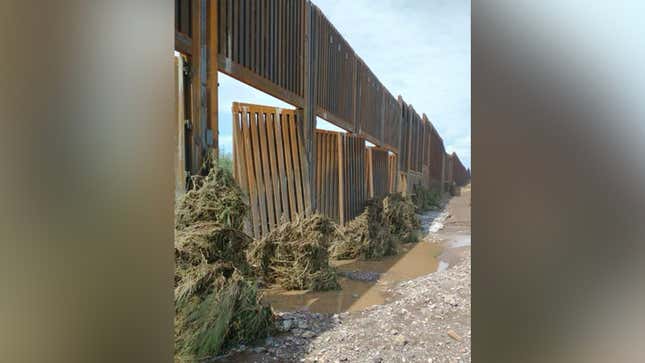
It turns out ignoring bedrock environmental laws may not have been the best choice for a multibillion-dollar construction project. Photos show former President Donald Trump’s border wall in deep disrepair after summer monsoon rains literally blew floodgates off their hinges.
The damage took place near San Bernardino Ranch, a historic site that sits between Douglas, Arizona, and the San Bernardino Wildlife Refuge. Much of the West is suffering through a deep megadrought, but the monsoon rains that have swept across parts of the Southwest this summer have doused the southern half of Arizona with record-setting rains. Douglas has seen nearly double its average monsoon season rainfall so far, including a blast that came through on Monday and unleashed flooding on the Arizona-Sonora border. The National Weather Service data shows 2.15 inches (5.5 centimeters) of rain fell, which in turn funneled into washes and drove flooding.
José Manuel Pérez Cantú, the director of the nonprofit Cuenca de Los Ojos, said in an email that six gates were washed out at this location alone. Other gates were also reportedly impacted by the heavy rainfall and flooding. The power and height of the waters can be seen in not just the heavy gates ripped open but the debris that wrapped around intact portions of the wall.
Who could have predicted this? Ah yes, just about everyone.
“I will build a great wall—and nobody builds walls better than me, believe me—and I’ll build them very inexpensively,” Trump said when he announced his run for president in 2015. “I will build a great, great wall on our southern border, and I will make Mexico pay for that wall. Mark my words.”
Mexico did not, in fact, pay for the wall, which led former Trump to declare a national emergency so he could funnel money from other federal projects and programs to build the wall. Nor was the wall inexpensive, costing the public billions in overruns. It was, however, chintzily built.
In the rush to build the wall, Trump sidelined environmental and cultural protection laws. Those laws are meant to protect the natural world and historically significant artifacts and sites. But they also serve the purpose of ensuring multibillion-dollar construction projects don’t face catastrophic failures within a few years of being built.
Much of the work was outsourced to private companies that raked in billions, including Southwest Valley Constructors, which did most of the work in Arizona. The company pulled in $2.7 billion in federal contracts and has faced lawsuits from private landowners who claim explosions tied to construction sent “car-sized boulders” onto their land. (There are also multiple OSHA complaints against the company, which is a whole other issue.) The location near San Bernardino Wildlife Refuge is one of a growing number of chinks in the rushed wall. Another section in Texas where levees were destroyed has left hundreds of thousands exposed to catastrophic flooding.
“It’s clear that these were not companies that really were taking the long term integrity of the product into account,” said Myles Traphagen, the borderlands program coordinator of the Wildlands Network. “The sad thing is that it was overseen by the Army Corps of Engineers. The Army Corps has a long and illustrious history... Taking off the environmental hat, when you’re building dams, the snail darters die out and salmon are affected. However, the bottom line is that there is an economic net gain by society ... whereas the border wall is a complete suck of money. We don’t benefit by any of that.”

It remains to be seen what the future holds for the wall. President Joe Biden has put a construction moratorium in place. Still, Trump managed to get 452 miles (727 kilometers) of wall built. That has created an environmental catastrophe for one of the most fragile ecosystems in North America, a place where the wildlife from the tropics, desert, and mountains mingle. Images captured during construction of iconic saguaros being razed as well as numerous environmental impact statements laid the risks bare, and Traphagen described camera trap photos his group has taken documenting everything from rare jaguars to common javelinas pacing along the wall in search of a way around.
The severe floods may have given them a passageway near San Bernardino. And the monsoons—which have become more intense due in part to the climate crisis—could rip further parts of the shoddily constructed wall asunder. But it’s clear that there’s a need for a much deeper reckoning and remediation.
“It’s not often that an ecologist can actually put a time stamp on the day that the evolutionary history of an area was sealed off,” Traphagen said. “Step number one [to reversing course] is to open up the gates where they exist and to remove sections of border wall in places where they’re having the greatest impact to species’ movement and migration.”